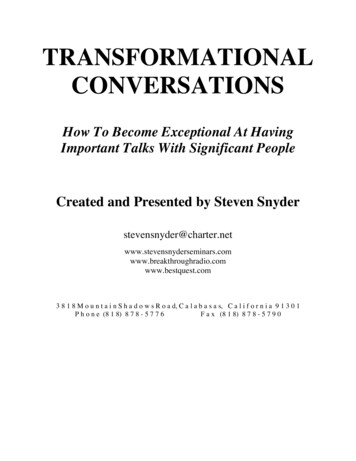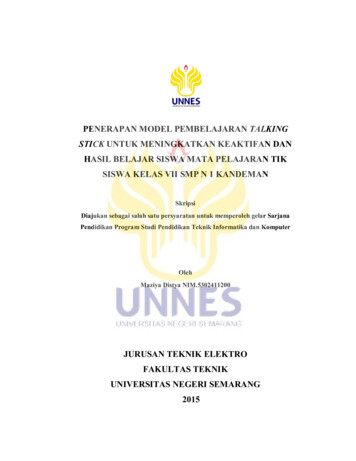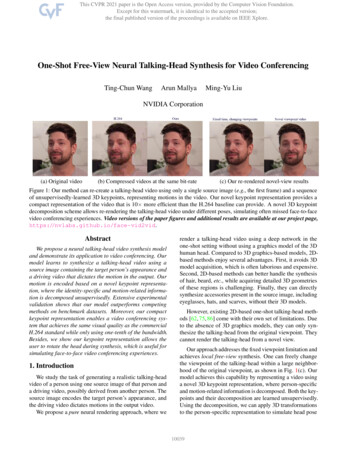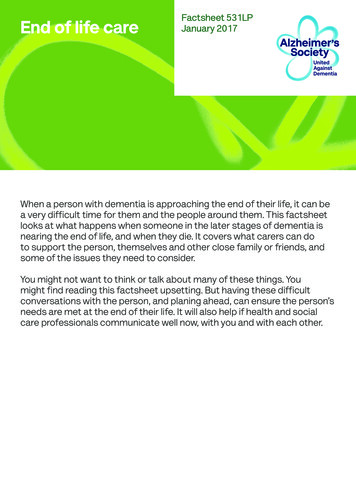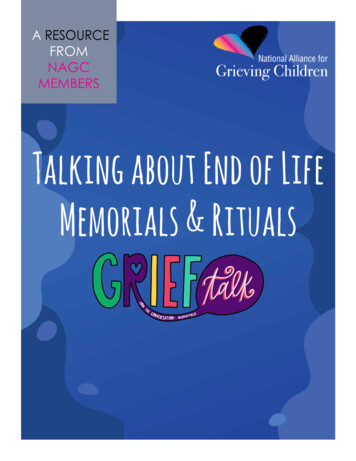
Transcription
A RESOURCEFROMNAGCMEMBERSTalking about End of LifeMemorials & Rituals
NAGC Grief Talk: Talking about End of Life Memorials & RitualsPage 2Grief Talk is an initiative of the NAGC launched in the summer of 2020 aimed atencouraging and supporting honest conversations around the topics of deathand grief. This initiative has produced the following resources:Talking to Children About Death and DyingTalking to a Child or Teen to Let them know Someone has DiedTalking about End of Life Memorials and RitualsTalking about Grieving as a FamilyVisit ChildrenGrieve.org to find these and other resources.Thank you to the following NAGC member organizations and individuals who contributed the contentfor this resource: (Listed alphabetically by last name. Highlighted names desigante the lead authors forthis guide.)Erin Brodbeck, LCSW, CT, Director of Grief Services, Sunset Funeral Homes (Champaign, IL)Karina Castillo, LCSW, Children’s Grief Support Program Manager, Community Hospice (Modesto, CA)Colleen Cherry, Founder, PlayWell Child Life Services(Laguna Niguel, CA)Alyssa Christensen, Grief Support Director, Mourning Hope Grief Center (Lincoln, Nebraska)Lauren Clarke, Program Manager, Bridges for End-of-Life (Charleston, SC)Lisa Conn, MSW, LISW-S, CAPT, Bereavement Counseling Professional, Ohio’s Hospice of Dayton (Dayton, OH)Pamela Gabbay, EdD, FT, Co-Founder, The Satori Group (Virginia Beach, VA)Peggy Galimberti, LMSW- Clinical, ACSW, Program Director, Ele’s Place (Ann Arbor, MI)Heather Gianatassio, Certified Child Life Specialist and Grief CounselorMelissa Lunardini, MA, MBA, CEO, Radical Grief, LLC (San Diego, CA)Valerie Myers MS, CT, CEO, Myers Compassionate Grief Services, LLC (Owings Mills, MD)Kaela O’Donnell, MSW, LCSWA, Program Therapist, KinderMourn (Charlotte, NC)Buffy Peters, Director, Hamilton’s Academy of Grief & Loss (Des Moines, Iowa)Irwin Sandler, Research Professor, Resilient Parenting for Bereaved Families (Phoenix, AZ)Corrie Sirota MSW, PSW, Clinical Social Worker & Psychotherapist, Author and Clinical Director of Myra’s KidsFoundation (Montreal, Quebec)Blair Stockton, MS, CCLS, CTP, CGCS, Compass Child and Teen Grief Services Coordinator, Four SeasonsHospice and Palliative Care (Flat Rock, NC)Copyright 2020 by National Alliance for Grieving Children. All rights reserved. You can quote, link to, repost or translate this article, in its entirety, as long as you credit the NAGC and add a working link back tothe NAGC’s website. www.ChildrenGrieve.org 2020 National Alliance for Grieving Children ChildrenGrieve.org
NAGC Grief Talk: Talking about End of Life Memorials & RitualsIntroductionEnd of life memorials and rituals thatfollow the death of someone lovedare very important. Memorials andrituals mark the transition of life todeath and provide an opportunity tohonor and reflect over the life of thedeceased. In addition, memorialsand rituals allows family, friends andthe community to gather togetherand support one another and thegrieving family.As these events offer support,comfort, and meaning for thosegrieving and provides a safe venuePage 3for the physical and emotionalexpression of grief, they are incrediblyimportant after a death.Use Concrete LanguageWhen talking with a child aboutthese rituals, one of the first things tobe sure that the child understandsis what it means when we say thattheir special person has died. Be sureto use concrete language and noeuphemisms in your conversation.Even for a small child they willunderstand, “when someone diestheir body stops working”.Use concrete language.For example, “Your grandpa had a heart attack and died. Thatmeans his heart stopped working and that made his body stopworking. Does that make sense?” 2020 National Alliance for Grieving Children ChildrenGrieve.org
NAGC Grief Talk: Talking about End of Life Memorials & Rituals7 Tips forTalkingto Bereaved Children& Teens about End of LifeMemorials/RitualsPage 4Grief is OngoingKids continue togrieve through eachdevelopmental milestone.Talk about the death.Help them to realize that this a normal and natural process. Whether youtalk about it or not, the child/teen will grieve. Normalizing the processhelps them to better understand their grief.Grief is shapedby culture.Grief is shaped byculture. Differentcultures andfamilies will have avariety of traditions,rituals and beliefsregarding end oflife ceremonies, andtheir views on grief.Validation is KeyThere is no such thing as goodor bad feelings- feelings arejust feelings and are called“feelings” because we are supposed to feel them. Avoid labeling certain feelings, such as anger, loneliness, sadness, or grief,as bad. This creates a negative connotation and affirms adesire to avoid such feelings.Instead, discuss with kids thatcertain feelings may be hardor more difficult to understand,process, etc., but encouragethem to talk to you about them. 2020 National Alliance for Grieving Children ChildrenGrieve.org
NAGC Grief Talk: Talking about End of Life Memorials & RitualsBe FlexibleIt doesn’t have to be allor nothing when it comesto the attending end oflife memorials & rituals.Give the child or teenpermission once theyhave had the opportunityto discuss what’s aheadto decide whether theyattend. Support them inthe decisions they make.Use Simple, DirectLanguageBe sure to use thewords: death, dyingand died. Using euphemisms and otherwords in place of “dead”can confuse the child(passed away, lost,etc.). They need simpleand direct language.Talk about death honestlyand use age appropriate language.2-5 years: Respond with simple,repeated explanations to theirquestions. Be truthful. Saying “I don’tknow” is more than okay. You’re notsupposed to have all the answers,and it’s okay for the child to knowthat.5-8 years: Focus on simple, direct,assurance, explanations. May becurious about death and recognizefinality. Keep in mind kids of this agegroup may avoid asking questionsas a way to “protect” the adultsin their life. Provide them withopportunities to ask questions. It iskey to model good coping skills.8-12 years: Conversations shouldacknowledge, reflect, accept, andreassure. Be honest. Support themwith information and answers toquestions. As with younger children,keep in mind that kids of this agegroup may avoid asking questionsas a way to “protect” the adultsin their life. Provide them withopportunities to ask questions. It iskey to model good coping skills.13 : Teens have the ability tobe more abstract in language.Respect privacy and listen withoutjudgement. Be attentive andsupport their searching for answers. 2020 National Alliance for Grieving Children ChildrenGrieve.orgPage 5
NAGC Grief Talk: Talking about End of Life Memorials & RitualsPage 6Remember, this is not a one-time conversation. Children willcontinue to process the death and grieve as they continue todevelop. As children grow and change, their concept and understanding of death also grows and changes.There is an expression that children “grow with grief”. This is especially evident at milestones in the child’s life where the absence ofthe person who died is felt more strongly. 2020 National Alliance for Grieving Children ChildrenGrieve.org
NAGC Grief Talk: Talking about End of Life Memorials & RitualsLet A Child’s Questions Lead TheConversationLet a child’s questions lead theconversation. If a child is old enoughto ask a question they are old enoughto hear the answer. Whatever thecause of death is, it is important thatwe are honest with children abouthow their person died. We all deservethe truth and hiding this informationcan cause distrust and hinder achild’s grief process. Remember,this is their story too. Where therewas attachment, there will be grief.When we aren’t honest with kids,resentment can build when thetruth finally comes out (and it willeventually). It’s never too late to havethat conversation.Keep in mind that children may askquestions over and over again. Thisis natural part of their process inlearning about death and how it is‘‘Page 7permanent. Just keep answeringthem honestly and consistently. Theyare trying to better understand, soeach time you answer they will gainmore insight. As their understandingof death grows so do their questions.When you are faced with a questionyou don’t have the answers to, itis okay to answer with an “I don’tknow.” If there is someone you canask to find out the answer, do thatand let them know in ways they canunderstand. If it is a question thatcan’t be answered, reply with, “Thatis a great question. I don’t know theanswer to that either, but tell memore about what you are thinkingabout with that.” In doing so, youare validating their questions andfeelings and allowing for exploration,which helps a child who is grieving.If a child is old enoughto ask a question theyare old enough tohear the answer. 2020 National Alliance for Grieving Children ChildrenGrieve.org
NAGC Grief Talk: Talking about End of Life Memorials & Rituals‘‘There are no “right” or“wrong” ways to feelafter someone hasdied. 2020 National Alliance for Grieving Children ChildrenGrieve.orgPage 8
NAGC Grief Talk: Talking about End of Life Memorials & RitualsDiscuss What Happens to the BodyChildren are naturally interested inlearning what happens to a bodyafter death. One explanation is thatafter someone dies, we take care oftheir body. The most common optionsfor the final disposition of the body isburial or cremation. Whether the bodyis buried or cremated, the end resultis the same: the body reduces to“ashes” – or only the bones remain.Page 9If the person’s body is cremated orburied, it is helpful to prepare a childand talk to them about what willtake place, what they can expect tosee and experience at the funeral/memorial service. For example, letthe child know that some people maybe laughing and telling funny stories,some may be crying, and some mayshow no emotion.Assure the child there are no “right” or“wrong” ways to feel after someonehas died. When we can properlyprepare the child for what they willexperience, they will be far less likelyto be afraid or uncomfortable in thisnew environment. 2020 National Alliance for Grieving Children ChildrenGrieve.org
NAGC Grief Talk: Talking about End of Life Memorials & RitualsPage 10TIP FOR TALKING TO CHILDRENUse clear, concrete, and age appropriate language whentalking about death to children.Example how to explain theprocess of cremation:The person’s body is placed intoa special box and then taken tothe crematory. In the crematory,the special box, with theperson’s body, gets placed intoa “chamber” or what looks likea large special oven, lined withbrick. The cremation chambergets very, very hot and the heathelps to change the person’sbody so that all that are left arethe bones or “ashes”. An Urn is aspecial container used to hold aperson’s ashes or “cremains”.Example how to explain theprocess of burial:The person’s body is placed intoa special box called a casketand then taken to a cemetery.There will be a special place inthe cemetery called a gravesitewhere the casket will be loweredinto the earth and covered backup. This site will be marked witha tombstone or a headstonethat records the name of theperson who is buried in thegravesite. 2020 National Alliance for Grieving Children ChildrenGrieve.org
NAGC Grief Talk: Talking about End of Life Memorials & RitualsPage 11Discuss the End of Life CeremonyExplain what the end of lifeceremony will entail and anyexpectations [i.e., specific dress,appropriate and inappropriatebehavior, rituals they may see andcan or cannot partake in, etc.]beforehand.To the best of your ability, explainthe why behind the type ofceremony that will happen. Childrendeserve and like to know the whybehind things. This can be anopportunity to educate your child(and yourself) on cultural practicesthat may differ from your own.If appropriate, ask the child howthey would want to be involved inthe services and follow their lead.Consider including the child/teen in the end of life ritual.Consider inviting the child to help make decisions. This gives themthe opportunity to be involved and gives them some sense of control in an out of control situation. They can help pick out the music,photos to display, the casket or urn color, etc.Another way to involve children is to invite them to draw a picture or write a letter to go in the casket or be cremated with their loved one. The child could readthe letter at the service or with other family members if they would like to shareit. 2020 National Alliance for Grieving Children ChildrenGrieve.org
NAGC Grief Talk: Talking about End of Life Memorials & RitualsPage 12Viewing The BodyIf the child is going to view theperson’s body, it is important to givethem a mental picture of what theywill be seeing first.One approach you can use tohelp guide you is the five sensesapproach: what will they see, hear,touch, taste, and smell.Discuss What theChild Will SeeDiscuss What theBody Will Look LikeBe sure you haveviewed the personand the room beforethe child, so you candescribe how theirperson’s body looksnow – i.e., ‘in a specialbox called a casket’; or‘on a special table witha pillow and coveredwith a blanket’- andwhat the layout of theroom is.Clarify that theirperson will look a lotlike they are sleeping:eyes are closed andlying down, but thisisn’t the same assleeping. When adultstell children that theirdeceased loved one is“just sleeping,” it cancause subsequentsleeping issues in thechild as they maythink they will neverwake up if they go tosleep. 2020 National Alliance for Grieving Children ChildrenGrieve.orgDiscuss What theBody Will Feel LikeTalk about what itwill feel like if theytouch the body –the person’s bodyisn’t “cold” – it is thetemperature of theroom because theblood is no longerflowing through theirbody. If the personis embalmed, letthem know that theskin will feel morefirm because of thepreparations madeto the body to get itready for the services.
NAGC Grief Talk: Talking about End of Life Memorials & RitualsAnswer Questions andConcernsAsk the child if they haveany questions or worries.Let the child take thelead as to when they areready to go in. Give thechild control over howclose they would like tobe to their person, andwhether or not they wantto see or touch the body.Make sure they knowthe choice is theirs, andeither way is “okay”.Respect and Honor theChild’s DecisionAfter getting all ofthe information andquestions answered,if a child decides, theydo not want to see theirperson’s body thatneeds to be respectedand validated. A childshould not be forcedto do anything wethink they may regretlater. There are alwaysalternatives. 2020 National Alliance for Grieving Children ChildrenGrieve.orgPage 13Gather MementosTalk with the personoverseeing the servicesto see if you can takea picture of the person,their hands, the casket,etc. if you think the childmight want to see itlater. And know if thisis before a visitationor wake, there are alsoother opportunities forthe child to change theirminds. Be sure to bringhome mementos like theprogram or folder fromthe service so the childcan have a keepsake.Share with them some ofthe things you observedor remember, who wasthere, and songs played,etc.
NAGC Grief Talk: Talking about End of Life Memorials & RitualsPage 14Suggestions for Duringthe Memorial or RitualEnd of life ceremoniesinclude, but are notlimited to: wakes,viewings/visitations,memorial services,graveside burials,internment, scatteringof ashes (crematedremains), church services,masses, funerals,receptions, and end of lifecelebrations.There is no one correct way tocommemorate the death of a lovedone. Culture, religion, and spiritualviews often play a role in how afamily or community decides tocommemorate someone’s death.A person may include their wishesfor how they would like theirfamily and friends to celebrate orcommemorate them in their will.Other times, death can be sudden orunexpected, so the person’s familyand friends decide if and how theywould like to hold an end of lifeceremony.Depending on who the end of lifeceremony is for, ask yourself and behonest about whether or not it maybe helpful to have a family memberor friend stay with your child(ren)throughout the process of theceremony. Non-immediate familymembers, friends, and those in yoursupport system are looking for waysto help and be of service to yourfamily during this time.Having someone as an assigned“buddy” allows you to partake inthe ceremony, be more present,and relieve you of the responsibilityof making sure your child is okaythroughout the process. Sit with yourchild beforehand to decide whotheir “buddy” will be and make thema part of that decision.REMINDER: Be honest about the potential emotional state you maybe in and normalize needing help when things are hard. 2020 National Alliance for Grieving Children ChildrenGrieve.org
‘‘NAGC Grief Talk: Talking about End of Life Memorials & RitualsPage 15Remember that youand your child canchoose which ritualsand aspects of the endof life ceremony thechild will participate in.Remember that you and yourchild can choose which rituals andaspects of the end of life ceremonythe child will participate in. Not allrituals will work and are appropriatefor all children- it depends upontheir ability to focus, maintainattention, and desire to participate.in an aspect of the ceremony. Forexample, children under the ageof four may not do as well duringa formal ceremony like a funeralor mass service. Still, they will beperfectly content at a less formalservice like a visitation or celebrationof life.Fortunately, it does not have tobe all or nothing. It’s okay for achild to decide not to participateSave mementos and share them with your child/teen.If you and your child decide they will not be a part of certainaspects of the ceremony, save mementos such as prayer cards,service programs, photos, flowers, etc. to share with them after thefact. 2020 National Alliance for Grieving Children ChildrenGrieve.org
NAGC Grief Talk: Talking about End of Life Memorials & RitualsIf there are opportunities for your child to be involved inthe ceremony, talk through those opportunities with thembeforehand and reassure them, it’s okay to change theirmind at any point. It may help to have a back-up planif they are struggling or decide they no longer want topartake in certain aspects of the ceremony.Additional tips Offer to stand with the child as they read/sing/playmusic/etc. if they decide to participate in the ceremony. Validate and normalize if you or your child need to takebreaks at any point during the ceremony. Show them aspace they can go to should they (or you) need a breakduring the ceremony. Arrive early to the ceremony’s location to give you andyour child plenty of time to get acclimated to the newenvironment. If applicable, introduce the child to the person in chargeof running aspects of the ceremony or service (example:Funeral Director, Celebrant, etc.) who can answer anyadditional questions about the process. Check-in with your child as you arrive and throughoutthe process. Ask what questions they have andencourage them to write things down throughout theceremony for you all to process afterward together.Page 16WAYS FORCHILDREN TO BE APART OF END OFLIFE CEREMONIES& RITUALSReading A Letter,Poem, Or PassageFrom A SpiritualTextPlaying MusicSingingDisplaying ArtworkPutting SomethingInside The Casket,Grave, Etc.Serving As APallbearerPassing OutCeremonyProgramsChoosing ASpecial Color ForEveryone To WearIn Honor Of ALoved One 2020 National Alliance for Grieving Children ChildrenGrieve.org
NAGC Grief Talk: Talking about End of Life Memorials & RitualsPage 17Alternative ideas if the child cannot attend the ceremony(due to restrictions, inability to travel, family dynamics, cultural considerations,etc.): If the service will be live-streamed, watch the service live or at a later timetogether. Have the child plan a service of their own. They can do it at the same timethe person’s ceremony would have been or on a special chosen day/time.Consider involving the child in the selection of a specific day. You couldpotentially coordinate with other family members, do together over FaceTime,Zoom, etc. During the ceremony, have everyone share their favorite memoriesof a loved one who died. Light a candle at a designated time in honor of the person who died. Visit the gravesite or other special place to leave a small keepsake, such as adecorated rock. Ask the child what they would like to do to honor their person and getcreative! (Technology can be beneficial in creating meaningful keepsakes forkids.)After the Memorial or Ritual Check in with your child and talk about their experience. Answer anyquestions they may have. Put away for safekeeping any item you saved from the funeral/ritual. As you are able, find your way in creating new routines, structure andpredictability into your life. 2020 National Alliance for Grieving Children ChildrenGrieve.org
Rememberance ActivitiesThese can be something you do once or can be done multiple times on specialanniversaries of birthdays, holidays, or other special occasions.Host a Remembrance EventFamily and friends join together andhave an impersonal time of reflectionof the person who died. (in-person orvirtually)Light a candle:Light a candle: Remind children thatlighting a candle can offer the comfortof thinking about the person who died,but when they blow the candle out,that does not mean they stop thinkingof them. Candles can be relit when achild or family wants. Children can alsodecorate the candle holder with wordsor pictures of the person that died.Release biodegradable balloons,butterflies, lanterns:You can have time with friends andfamily where you write notes to theloved one, read them aloud, or sendthem up with the balloons or lanterns.Create a Memory book of letters fromothers about the person who diedHave others whoknew their personwrite a letter ofwhat that personmeant to themor a special storythey would like toshare. This can besomething special the child and familycan keep for a lifetime.Share a memoryTelling stories and sharing memories is agreat way to continue to feel connectedto the person who died. They are such aprecious gift for the family. 2020 National Alliance for Grieving Children ChildrenGrieve.org
Honor the deceased throughcharitable deedsParticipate in a walk or race, start afoundation, or make a donation.Journal thoughts and feelingsCreate a memory shelf or memorybox to keep special mementosAppropriate for any age, this isespecially important for teens!Seek out a support group/campGive yourself the time and spaceto process grief and sharememories. Find support near you atchildrengrieve.org/find-support.Visit the gravesite or othermeaningful placeVisiting the gravesite can allowchildren to reflect on where theperson is buried. TIP: Explain tochildren that there is no pressure inroutinely returning to the gravesiteunless they want to.write a letter or make a card togive to the surviving familyLet the familyknow theyare in yourthoughts. 2020 National Alliance for Grieving Children ChildrenGrieve.org
Rememberance ItemsUtilize items that belonged to the person that died that children can keep with them orcreate to remind them of their special person.JEWELRY/ JeWElry With AshesJewelry such as necklaces,watches, rings that the childcan hold onto to rememberthe person. Many piecesare available that containashes or are even madefrom ashes.Blanket, stuffed animal or pillow Create/decorate a memory stoneout of clothingand put in a special place.Important: Make sure thechild is ready for the clothesto be cut up. Ask themif they would like to beinvolved in the process.Plant a treeHandkerchief or other personalitemPlant a tree in memory in afavorite park. TIP: If plantinga tree, think of whether thisis a place you know thatyou can always return to(for instance, if you movehouses, sell property, etc.).Framed picture of the person whodiedGet a memorial benchClothingDedicate a memorial benchor get garden marker thatcan be painted or a plaqueplaced on in remembranceof the person who died.Clothing that the child canwear or wrap up in duringtimes they miss the personSmall urn of ashes.Tip: Create a space wherethe urn can sit where thechild feels it is best for thembut also safe from damage. 2020 National Alliance for Grieving Children ChildrenGrieve.orgHang a WindchimeHang a windchimewhere when themusic plays, youcan think of theperson that diedand the melodythey brought to your life.
NAGC Grief Talk: Talking about End of Life Memorials & RitualsPage 21When to seek additional supportAfter a death, it is important to monitor changesin frequency, intensity, and duration of familymembers’ behaviors. Noticeable changes mayrequire additional support from an experienced,trained professional.Below are some examples of changes to look for: Inability to go to work or schoolDifficulties in relationshipsSleep problems or nightmaresDisproportionate anger or irritabilityIncreased health issuesFeelings of hopelessnessSocial withdrawalSelf-harm, suicidal thoughts or suicidal ideationThese changes can have an impact on the griever and the other familymembers. When changes in behavior go unnoticed and unaddressed, thiscan create an imbalance within the family. Addressing these changes willhelp create a supportive and safe environment for each member of thefamily.Sometimes members in a family may want to connect with others foradditional support. Connecting family members with peer support groups,camps, conferences, or even another person with a similar loss can helpprovide an added layer of support. These outside connections provide thegriever with an opportunity to learn new perspectives on grief, coping, andhealing.Connecting with others allows the griever to share their story, understand thatthey are not alone, validate and normalize their experience. It is important toembrace a family members’ readiness, as well as the type of support needed.Needs may vary among family members throughout their grief journey.You can find additional support in your area by visiting childrengrieve.org/find-support. 2020 National Alliance for Grieving Children ChildrenGrieve.org
Learn more at www.ChildrenGrieve.org 2020 National Alliance for Grieving Children ChildrenGrieve.org
End of life memorials and rituals that follow the death of someone loved are very important. Memorials and rituals mark the transition of life to death and provide an opportunity to honor and reflect over the life of the deceased. In addition, memorials and rituals al


